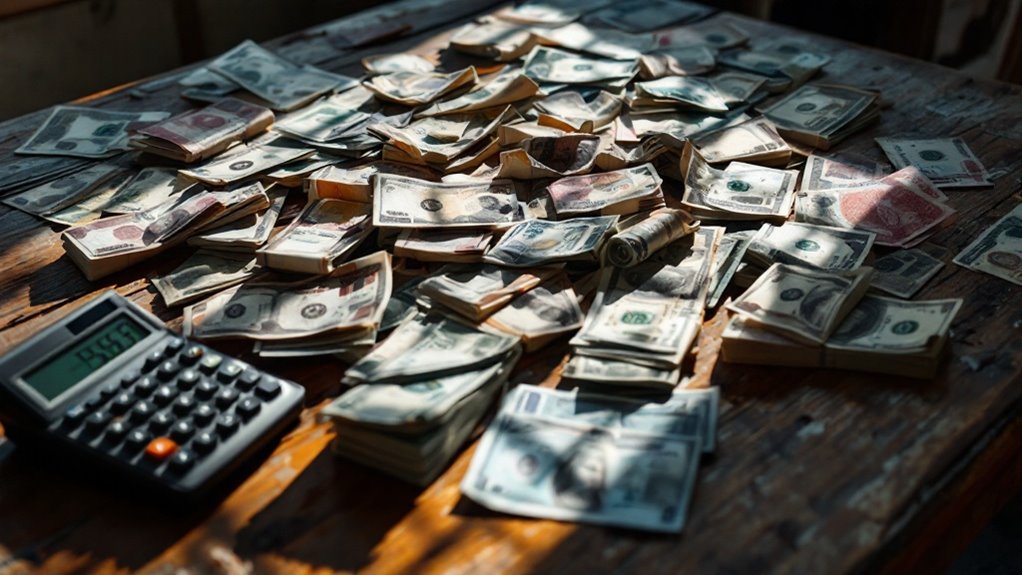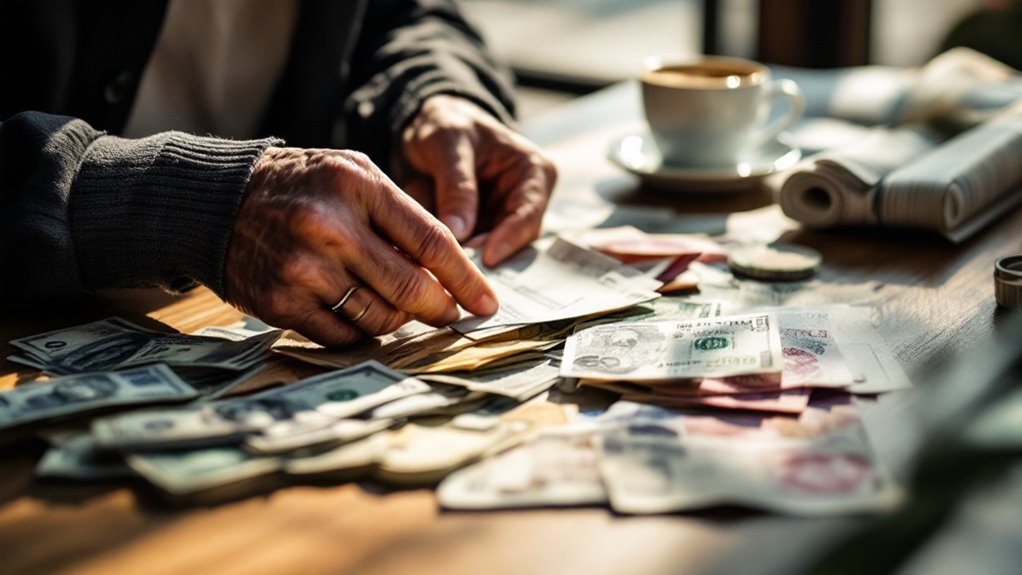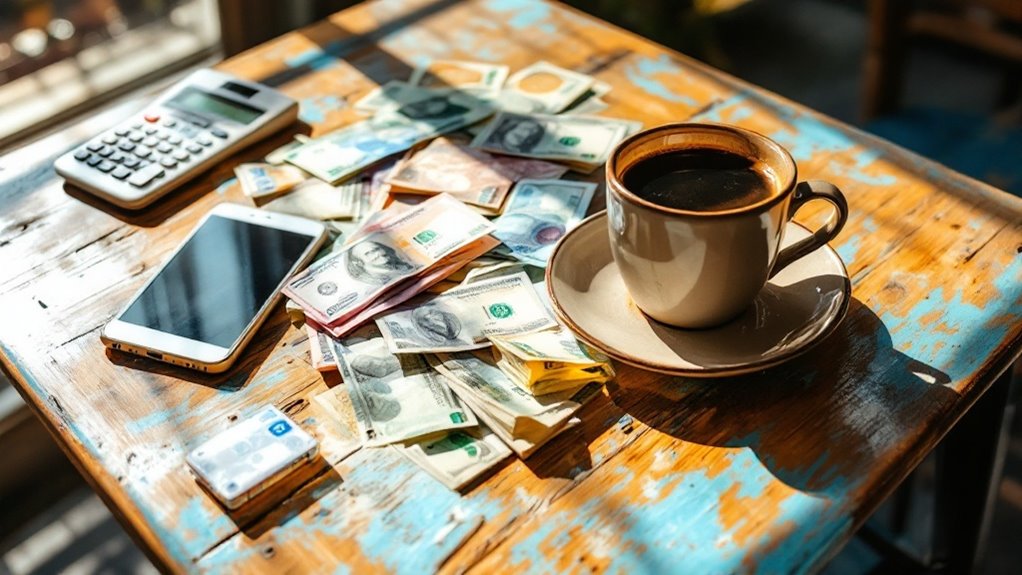Physical Address
304 North Cardinal St.
Dorchester Center, MA 02124
Physical Address
304 North Cardinal St.
Dorchester Center, MA 02124

Argentina's complex currency system means you'll encounter two main exchange rates: the official rate and the "dolar blue" (parallel market rate). While the official peso-to-dollar rate is government-controlled, the blue rate often offers better value for travelers. You'll need to navigate both markets carefully, using Western Union for transfers and carrying crisp $100 bills for the best rates. Understanding these dynamics will help you maximize your money's worth in this unique financial landscape.

While Argentina's parallel currency market may seem like a modern phenomenon, its roots trace back to decades of economic turmoil and financial instability. You'll find its origins in the devastating 2001 economic crisis, when the peso's value plummeted and the government restricted bank withdrawals through the infamous "corralito."
This wasn't the first time Argentines had lost faith in their currency. If you'd lived there in the 1980s, you'd have witnessed hyperinflation reaching a staggering 3,000% between 1975 and 1990.
People naturally turned to the US dollar as a lifeline, creating an informal market that would later become known as the "blue dollar." When the government defaulted on $132 billion in debt in 2001, it only reinforced what many already knew: they needed alternative ways to protect their savings. Today, with an annual inflation rate of 272%, the parallel market remains as crucial as ever for Argentinians seeking to preserve their wealth.
Since President Milei's dramatic peso devaluation in December 2023, Argentina's notorious gap between official and parallel exchange rates has shrunk to historic lows.
You'll find the current "brecha" (gap) hovering around 1.45%, a stark contrast to the 200% spread that plagued the economy just a year ago.
Here's what's driving this remarkable convergence:
While the narrowing gap signals progress, you should note that underlying challenges persist – including triple-digit inflation and negative central bank reserves of USD 6.9B. Tourists are advised to bring pristine $100 bills for the most favorable exchange rates when converting their currency.
Progress on currency gap masks deeper economic wounds: soaring inflation and billions in negative reserves continue to threaten Argentina's recovery.
The stability's staying power will depend on continued reforms and export growth.

Living with Argentina's multiple exchange rates requires mastering three essential daily strategies to protect your money's value.
First, you'll want to use Western Union for international transfers, as they offer competitive CCL rates and waive fees for first-time users. The volatile peso means that transactions through informal blue channels can reach up to 600 pesos per dollar.
Second, you'll need to carefully manage your cash holdings – carrying crisp $100 USD bills will get you the best blue dollar rates at informal exchanges, while avoiding ATMs with their hefty fees.
Finally, you'll benefit from using digital payments strategically: foreign credit cards automatically convert at MEP rates, while local cards face tourist dollar taxes.
Although Argentina's multiple exchange rates may seem intimidating, they can actually work to your advantage as a tourist in this vibrant South American nation.
With 410,000 international visitors recorded in October 2022, Argentina has firmly reestablished itself as a premier tourist destination.
You'll find that traversing the system can lead to significant savings, especially when you understand how to leverage the MEP rate for credit card purchases, which offers 78% more pesos than official rates.
To make the most of your Argentine adventure:
With tourism contributing over $15.5 billion to Argentina's economy, you'll join millions of visitors who've discovered this fascinating dual-currency destination where your money can stretch surprisingly far.

Beyond the tourist-friendly credit card transactions lies Argentina's bustling street economy, where "cuevas" – hidden currency exchange houses – form the backbone of everyday financial life.
You'll find these unofficial exchanges tucked away in private offices, where operators track minute-by-minute fluctuations in the blue dollar rate to serve a steady stream of locals converting their pesos.
While cash usage in supermarkets has dropped to 17%, it's still king in the informal sector, where 72% of workers rely on physical currency. The strict BCRA controls on official currency exchanges have inadvertently fueled the growth of these alternative markets.
Physical cash remains the lifeblood of Argentina's informal economy, even as digital payments dominate mainstream retail.
Merchants often sweeten the deal with 5-15% discounts for cash payments.
Despite being technically illegal, these parallel currency markets have gained widespread acceptance – a whopping 68% of Argentinians consider them legitimate, with the system handling an estimated $5B in monthly transactions.
Since President Milei took office, Argentina's bold economic reforms have begun reshaping the nation's financial landscape.
You'll see dramatic changes in how the country's tackling its economic challenges, with promising results already emerging in key areas.
Here's what you need to know about the market's response to these reforms:
The zero-deficit policy's working its magic, even with a 3.5% GDP hit in 2024.
These reforms mark a significant shift from years of self-inflicted policies that created an unstable macroeconomic environment.
While there's still work to be done, you're watching Argentina's economy transform in real-time.

While Argentina's economic reforms show promise, maneuvering currency exchange requires smart safety measures to protect your money.
You'll want to use anti-theft accessories like money belts and keep your cash divided into smaller amounts across secure locations.
When exchanging currency, stick to reputable *cuevas* on busy streets like Calle Florida, and always verify bills under UV light for authenticity.
With inflation rates reaching nearly 300 percent, prices can change dramatically within days, so exchange only what you need for immediate expenses.
Watch for those telltale security features: blue strips and watermarks on dollars, raised textures on pesos.
For added peace of mind, consider using Western Union transfers or credit cards with MEP rate conversion instead of carrying large amounts of cash.
If you're bringing more than $10,000, don't forget to declare it at customs – your vacation shouldn't include any unexpected legal hassles.
Although Argentina's currency markets face significant turbulence, promising signs emerge for 2025 as President Milei's reforms take root.
You'll see major changes in the financial landscape, with inflation expected to cool down to around 23% – still high, but better than the hyperinflation of recent years.
Recent data shows the peso has fluctuated between 939.1 and 1003 ARS per US dollar, indicating ongoing market volatility.
Here's what you can expect in the coming months:
You'll want to watch these developments closely, as they'll shape both investment opportunities and daily transactions in Argentina's evolving economy.
You'll find Argentina's currency situation remains complex but fascinating, with the dolar blue trading at nearly triple the official rate in late 2023. While street money changers and dual pricing continue to shape daily life, recent economic reforms suggest potential changes ahead. Whether you're planning a visit or following from afar, understanding Argentina's unique currency landscape provides essential insight into how 46 million people navigate this financial reality.